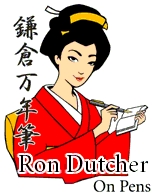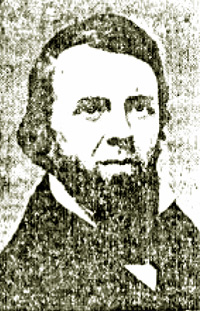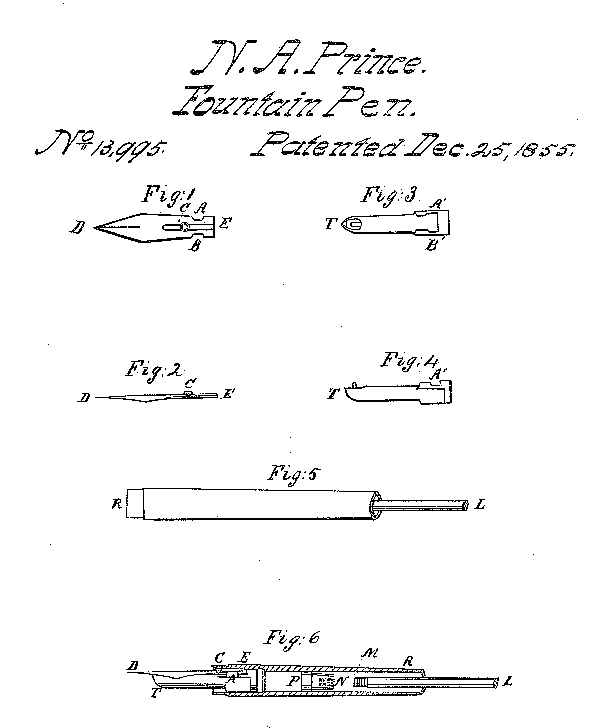
Ever since I learned that Mark Twain once used a Prince Protean pen, I have
been trying to find one. I’d be willing to pay several thousand dollars
for one, but even if you had a million to spend it would be doubtful you could
find one of these very early pens. And by early, I mean one of the first fountain
pens manufactured in the United States.
When Mark twain wrote letters praising his new MacKinnon Stylographic pen,
he told how much better it was than the Prince and how he had flung it out
his window. Francis Cashel Brown, of Caw’s Pen and Ink, who incidentally,
had earlier been the treasurer of the Mackinnon Pen Company, explained that
in 1851, Newall A. Prince’s Protean Fountain pen had been released and
for a short time was widely popular. However, the first Proteans’ had
steel parts and quickly corroded in the acidic ink of the day. They soon stopped
writing - not that they wrote well to begin with.
Nevertheless, we are talking of the 1850’s, a fountain pen manufactured
before the Civil War, and roughly 35 years before Lewis Waterman would patent
his famous three channel feed.
I recently found an article from the 1908 Boston Herald that gives a detailed
history of Newall Prince and his pen. It is rather well written so I will include
it here in its entireity:
MINISTER INVENTED THE FOUNTAIN PEN
It was a New England clergyman, Rev. Newell Anderson Prince, a Congregational
minister of exceptional ability and rare mental attainments, who conceived,
invented, and had patented the first fountain pen. Mr. Prince was a direct
descendant of
Rev. John Prince, an Oxford scholar and church of England clergyman of East
Sheffield, England, who was the ancestor of Rev. Thomas Prince, who came
to America in 1623,
and became first pastor of the Old South church in Boston. He was the son
of Paul and Abigail (Reed) Prince and one of three sons, all of whom were
graduates
of the North Yarmouth academy and of Bowdoin College. One of his brothers
was Rev. William Reed Prince of the class of ‘40, Bowdoin, the same year that
Rev. Newell A Prince graduated, and who was also a Congregational minister of
great ability. The other brother was Howard Lyman Prince, who fought in the Mexican,
Indian and civil wars, and who was made judge advocate on Gen. Chamberlain’s
staff.

Newall Prince
After the war he was principal of the high school in Portland, Maine, and
later studied law and practiced in Washington for many years. When Rev. Mr.
Prince graduated from Bowdoin, he took a four years’ course in the Bangor
theological seminary, graduating in 1844. Before actively taking up his ministerial
duties, Mr. Prince taught school in Freeport, Falmouth and Bath, Maine, Paris,
Kentucky, and Milltown, New Brunswick. In 1847, he became pastor of the Congregational
church in New Gloucester, Maine but later went to Milltown, New Brunswick.
He was during his life the pastor of churches in Boston, Brooklyn, Paterson,
NJ, Bethel, Conn, Orange Mass., Union Springs, NY, Binghampton, NY, Simsbury,
Conn., New Haven, Cornwall, Conn., Enfield, Conn., Auburn, Mass, and West Suffield,
Conn.
It was when Mr. Prince was a student at Bowdoin that the idea of the Fountain
pen came to him. Shorthand writing was at that time in its infancy, and Mr.
Prince, with his brothers and Daniel Temple, who afterward became a clergyman
and missionary, took up the study of shorthand together. After a time Mr. Prince
discovered, however, when he had reached the stage in this study of taking
from dictation, that the constant dipping of the pen was not only a loss in
speed, but it left him at times with a stenographic character half formed.
Wishing to excel in this new method of condensing the English language, it
occurred to him then, that, if a self-feeding pen could be devised, where there
would be a constant flow of ink, regulated to suit the needs of the writer,
writing of shorthand characters would be greatly simplified, with the result
of greater speed and accuracy. He studied over it for several months without
telling any of his student friends of his hopes. He tried many experiments,
all of which were failures, but he was a persistent youth, and his ingenuity
won.
His first successful pen was very crude, but it worked. He went to a local
tinsmith and had made for him a barrel of tin about half an inch in diameter
at the top and tapering to three-eighths of an inch at the bottom. It was 12
inches in length and very clumsy to handle. At the smaller end he made an indentation
in such a way that a pen could be inserted. The pens in those days were flat,
and it was a flat steel pen that he used in his first tin penholder. He filled
the barrel with ink and in the top he placed a cork with a vent hole in it
to allow for the admission of air. The indentation at the bottom was made in
such a way that the flow of ink was regulated by the tightness with which the
pen was inserted. He first tried it in his room secretly and found that it
worked well, and the next day, to the amusement of every one in the study room,
he produced his tin-barreled fountain pen and proceeded to do his work..
It is said that this was in 1839, the year before Mr. Prince graduated. At
any rate, it caused a mild sensation, and several of the students were soon
provided with this tin fountain pen, and used them in their work in the class
rooms. This was the first fountain pen of which there is any record and to
Bowdoin college falls the honor of its birthplace.
For several months the possibility of a fountain pen of commercial value did not
occur to this inventive genius, but it soon found lodgment just before his
graduation and he began the task of perfecting it with the idea of securing
a patent on it at Washington. All through his four years in the Bangor theological
seminary, while he was a teacher and pastor in several places, he kept this idea in mind and worked to perfect his invention, but it was not until 1830
that he had overcome all the obstacles and was ready to ask for his patent
papers.
His first commercial pen had a silver barrel about 8 inches long and three-eights
of an inch in diameter. In one side of this barrel there was an opening about
two inches long and three-eights of an inch wide, over which was placed a
flexible rubber tube and steel spring. The barrel being filled with ink,
the
pressure of the thumb on the steel spring, which in turn pressed on the rubber
tube, regulated the flow of ink. It was a complicated affair of several parts
but it worked well.

The Prince Protean Fountain Pen Patent On September 30, 1851, Mr. Prince took out his first patent. He called it
the “Prince Protean Fountain Pen,” or changeable pen. As an inventor
Mr. Prince was a success, but of business he knew little. Immersed in his books,
his studies, his writings and his inventions, he had no idea of business, and,
like many of good clergymen and inventors, he was all at sea when he began
his search for the means to manufacture and to place his invention on the market.
He went to live in Brooklyn, and while there filled many Brooklyn pulpits,
and became the close friend of such men as Henry Ward Beecher, Rev Lyman Abbott,
and other noted New York clergymen. He was for a time Mr. Beecher’s supply
in the pulpit of Plymouth Church. In 1854 he met by accident Mr. Thomas G.
Stearns, who was at the time a New York merchant, but who afterwards amassed
a fortune in railroad building and construction work. Mr. Stearns is alive
today, and although 92 years old is as strong and active as a man of 60. ...
“
He was a remarkable man in many ways,” Stearns said to the Globe man. “He
was a splendid preacher and inventor, but he had absolutely no idea of business.
If he had been a good business man there is no doubt at all but that he would
have made a tremendous fortune out of his pen.”
Mr. Stearns had faith in the “Prince Protean Fountain Pen” and
although Mr. Prince retained but 1-16th of his interest in the invention, Mr.
Stearns and John C. Clark, who was engaged in the manufacture of pencil cases
in New York, agreed to finance a company to exploit Mr. Prince’s invention.
The company was known as the Prince Pen Co. And Mr. Stearns became the manager.
Mr. Prince was pastor of a Congregational church in Auburn, Mass, from 1879
until 1883 and went from that place to West Suffield, Conn, taking charge of
a church in that place. He died there April 5, 1887, aged 72. During his life
he published a volume of sermons and wrote and published the memoirs of his
brother, Rev. William Reed Prince, besides contributing largely to current
Congregational literature and discussions. His volume entitle “Being
to Be,” a work on immortality, was widely read at the time of its publication.
Mr. Prince married Mrs. Mary R. Burnham of Brooklyn, and when he died he was
survived by a wife and daughter, the later, Miss Maybelle Oakes Prince, is
now living in Springfield, Mass. She has inherited much of her father’s
literary ability and charm and is well known in that city as a writer on sociological
subjects being a frequent contributor to current literature.
If anyone actually has a Prince pen, I would certainly like to make your
acquaintance.
Stay Well,
Dr. Ron Dutcher
www.kamakurapens.com

Ron Dutcher has lived in Japan for over 15
years. He is a member of the Tokyo Pen Association, and has learned a great deal
from Japanese pen collectors. He sells a great many Japanese pens on ebay under
the name Kamakura-Pens, but his true love is for early American pens. He can be
contacted at rd@kamakurapens.com

|